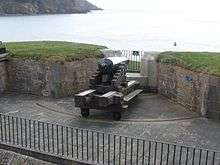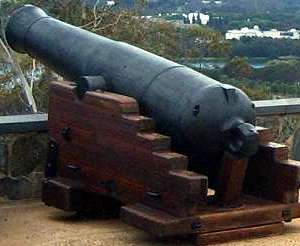RML 64 pounder 71 cwt gun
| Ordnance RML 64 pounder 71 cwt gun (converted) | |
|---|---|
|
No. 398 made by Royal Gun Factory in 1870, at the Royal Australian Artillery Memorial, Canberra | |
| Type |
Naval gun Coast defence gun |
| Place of origin | United Kingdom |
| Service history | |
| In service | 1870 - 190? |
| Used by |
Royal Navy Australian Colonies |
| Production history | |
| Designed | 1870 |
| Manufacturer | Royal Arsenal |
| Specifications | |
| Weight | 7,896 pounds (3,582 kg) |
| Barrel length | 103.27 inches (2.623 m) (bore)[1] |
|
| |
| Shell | 64 pounds (29.03 kg) |
| Calibre | 6.3-inch (160.0 mm) |
| Muzzle velocity | 1,230 feet per second (370 m/s)[2] |
The RML 64 pounder 71 cwt guns (converted) were British rifled muzzle-loading guns converted from obsolete smoothbore 8-inch 65 cwt shell guns.[note 1]
Design

When Britain adopted rifled ordnance in the 1860s it still had large stocks of serviceable but now obsolete smoothbore guns. Gun barrels were expensive to manufacture, so the best and most recent models were selected for conversion to rifled guns, for use as second-line ordnance, using a technique designed by William Palliser. The Palliser conversion was based on what was accepted as a sound principle that the strongest material in the barrel construction should be innermost, and hence a new tube of stronger wrought iron was inserted in the old cast iron barrel, rather than attempting to reinforce the old barrel from the outside.[1]
This gun was based on the cast-iron barrel of the 8 inch 65 cwt gun, which previously fired a shell weighing 50 pounds. The 8-inch gun was bored out to 10.5 inches and a new built-up wrought iron inner tube with inner diameter of 6.29 inches was inserted and fastened in place. The gun was then rifled with 3 grooves, with a uniform twist of 1 turn in 40 calibres (i.e. 1 turn in 252 inches), and proof fired. The proof firing also served to expand the new tube slightly and ensure a tight fit in the old iron tube.[1]
Deployment

This nature of gun was initially issued for Sea Service (SS), but by 1886 were obsolete in that role and were being returned to store for re-issue for Land Service (LS).[3] In Naval service they were deployed on many smaller British cruising warships around the world.

In Land service many were mounted for coast defence in both British and colonial locations. They were mounted on a wide variety of iron and wooden carriages. They became obsolete for coast artillery use in 1902, whereupon most of them were scrapped and disposed of.
See also
- RML 64 pounder 64 cwt gun the equivalent new design frontline 64-pounder gun
- List of naval guns
Surviving examples
- Gun number 142, dated 1869 at St Helier, Jersey
- Gun number 483, dated 1870. One of two at Dartmouth Old Battery, Devon, UK
- A gun from 1872 at Southsea Castle, UK
- 2 guns, No. 398 and 407 at the Royal Australian Artillery Memorial, Mount Pleasant, Canberra, Australia
- A gun at Mays Hill Cemetery, Parramatta, New South Wales, Australia
- A gun outside the wardroom at HMNZS Philomel, Auckland, New Zealand
- A gun on a locally-made carriage at Army Memorial Museum, Waiouru, New Zealand
- Gun at Fort St. Catherine, St George, Bermuda
Notes
- ↑ "71 cwt" refers to the gun's weight rounded up to differentiate it from other "64-pounder" guns : 1 cwt = 112 pounds.
References
- 1 2 3 Treatise on Construction and Manufacture of Service Ordnance, 1879, pages 233-238, 292
- ↑ 1,230 feet/second firing 64-pound projectile with charge of 8 pounds gunpowder. Treatise on Construction of Service Ordnance 1879, page 94
- ↑ Treatise on Construction and Manufacture of Service Ordnance (3rd ed), HMSO, 1886, pages 219
Bibliography
External links
| Wikimedia Commons has media related to RML 64 pounder 71 cwt Gun. |
- Handbook for the 64 - pr. R. M. L. converted guns of 58 and 71 cwt. L. S., 1887, 1892, 1898, 1902 at State Library of Victoria
- WL Ruffell, RML 64-pr 71-cwt
